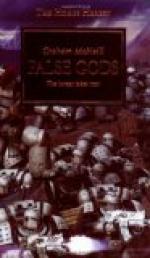“Watcher gawkin’ at?” demanded the youth, grinning up at the staring Simpkins. “Lose dat farmer-boy face or it’s back to de ole homestead for youse. Her royal nibs ain’t lookin’ for no good milker.”
“Oh, I’m just rubbering to see where the goat’s kept,” the reporter answered, trying to assume a properly metropolitan expression. “Suppose I’ll have to take the third degree before I can get out of here.”
The youth started noiselessly across the floor, and Simpkins saw that he wore sandals. His own heavy walking boots rang loudly on the flagged floors and woke the echoes in the vaulted ceiling. He began to tread on tiptoe, as one moves in a death-chamber.
And that was what this great room was: a charnel-house filled with the spoil of tombs and temples. The dim light fluttered down from quaint, triangular windows, set with a checker-work of brick-red and saffron-colored panes about a central design, a scarlet heart upon a white star, and within that a black scarabaeus. The white background of the walls threw into relief the angular figures on the frieze, scenes from old Egyptian life: games, marriages, feasts and battles, painted in the crude colors of early art. Between were paneled pictures of the gods, monstrous and deformed deities, half men, half beasts; and the dado, done in black, pictured the funeral rites of the Egyptians, with explanatory passages from the ritual of the dead. Rudely-sculptured bas-reliefs and intaglios, torn from ancient mastabas, were set over windows and doors, and stone colossi of kings and gods leered and threatened from dusky corners. Sarcophagi of black basalt, red porphyry and pink-veined alabaster, cunningly carved, were disposed as they had been found in the pits of the dead, with the sepulchral vases and the hideous wooden idols beside them.
The descriptions of the place had prepared Simpkins for something out of the ordinary, but nothing like this; and he looked about him with wonder in his eyes and a vague awe at his heart, until he found himself standing in the corner of the hall to the right of the black altar in the west. Two sarcophagi, one of basalt, the other of alabaster, were placed at right angles to the walls, partially inclosing a small space. Within this inclosure, bowed over a stone table, sat a woman, writing. At either end of the table a mummy case, one black, the other gilt, stood upright. The boy halted just outside this singular private office, and the woman rose and came toward them.
Simpkins had never read Virgil, but he knew the goddess by her walk. She was young—not over thirty—and tall and stately. Her gown was black, some soft stuff which clung about her, and a bunch of violets at her waist made the whole corner faintly sweet. Her features were regular, but of a type strange to Simpkins, the nose slightly aquiline, the lips full and red—vividly so by contrast to the clear white of the skin—and the forehead low and straight. Black hair waved back from it, and was caught up by the coils of a golden asp, from whose lifted head two rubies gleamed. Doubtless a woman would have pronounced her gown absurd and her way of wearing her hair an intolerable affectation. But it was effective with the less discriminating animal—instantly so with Simpkins.




